Employability Skills in Health and Social Care: A Comprehensive Analysis
VerifiedAdded on 2024/07/01
|16
|4495
|293
AI Summary
This report delves into the essential employability skills required in the Health and Social Care industry, focusing on the responsibilities and performance objectives of a caregiver. It explores work-based problems like ineffective communication and interpersonal conflicts, and proposes solutions using various communication styles and time management strategies. The report also analyzes team dynamics and suggests alternative ways to complete tasks and achieve shared goals, highlighting the importance of teamwork in healthcare.
Contribute Materials
Your contribution can guide someone’s learning journey. Share your
documents today.
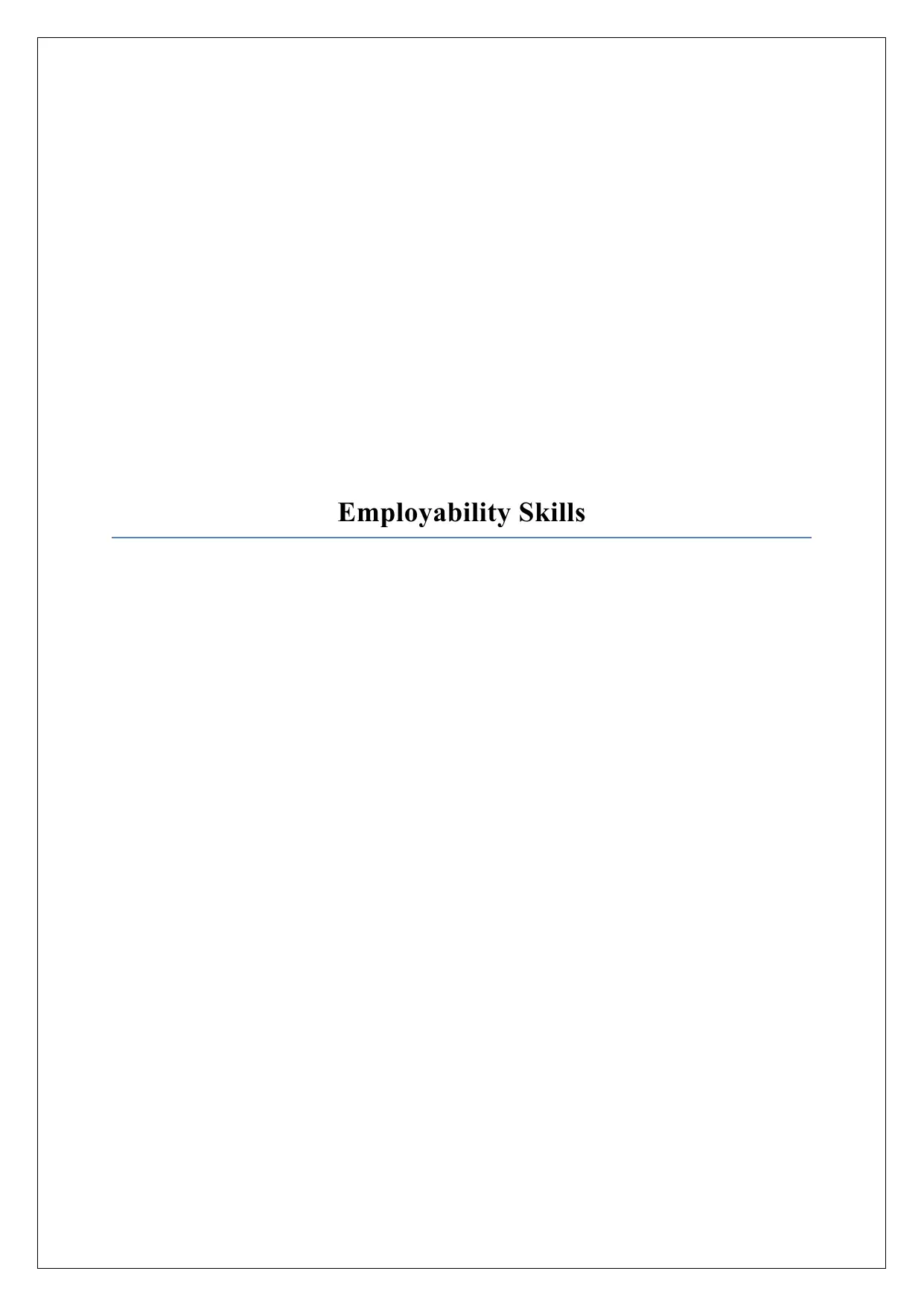
Employability Skills
Secure Best Marks with AI Grader
Need help grading? Try our AI Grader for instant feedback on your assignments.
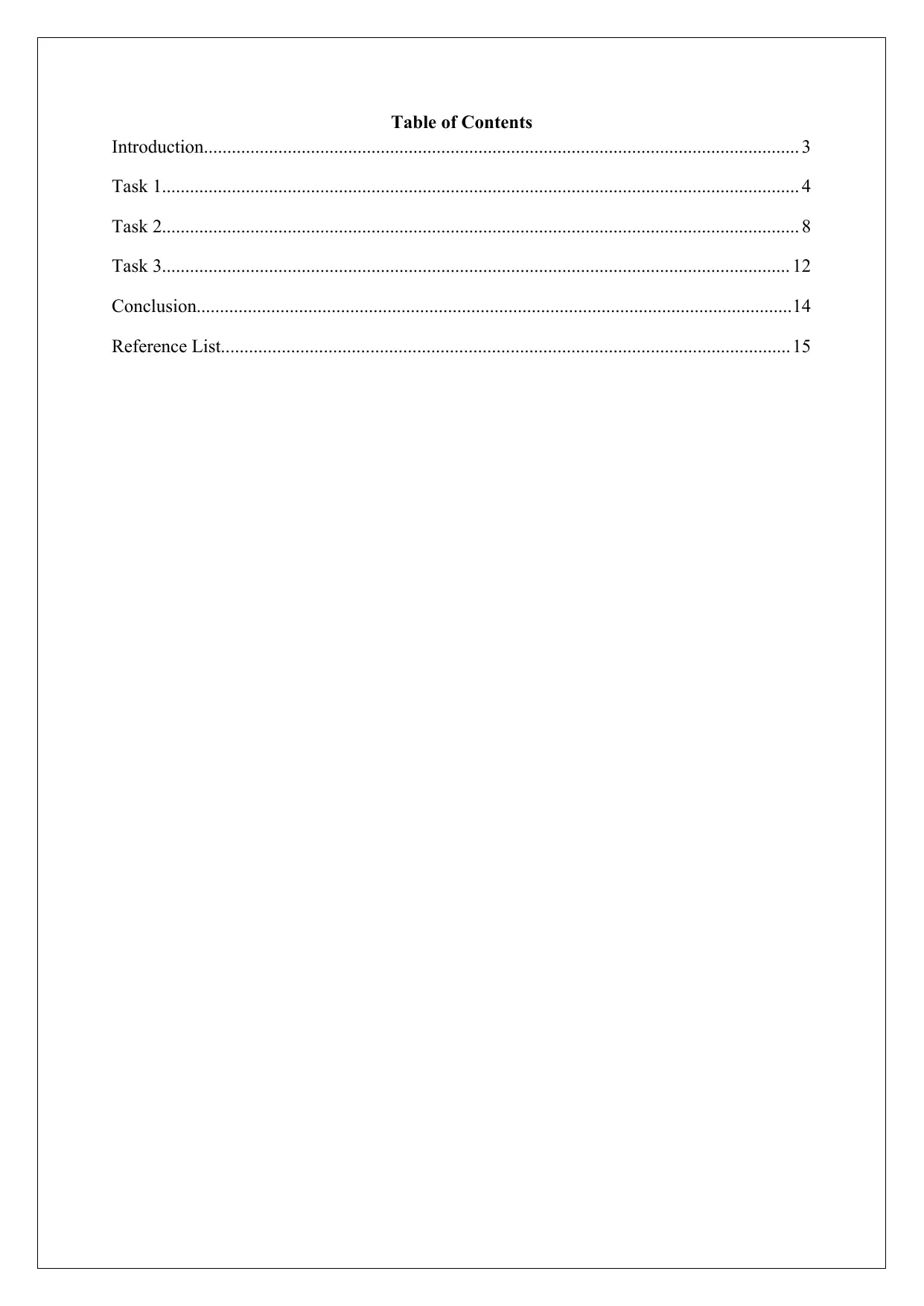
Table of Contents
Introduction................................................................................................................................ 3
Task 1......................................................................................................................................... 4
Task 2......................................................................................................................................... 8
Task 3....................................................................................................................................... 12
Conclusion................................................................................................................................14
Reference List..........................................................................................................................15
Introduction................................................................................................................................ 3
Task 1......................................................................................................................................... 4
Task 2......................................................................................................................................... 8
Task 3....................................................................................................................................... 12
Conclusion................................................................................................................................14
Reference List..........................................................................................................................15
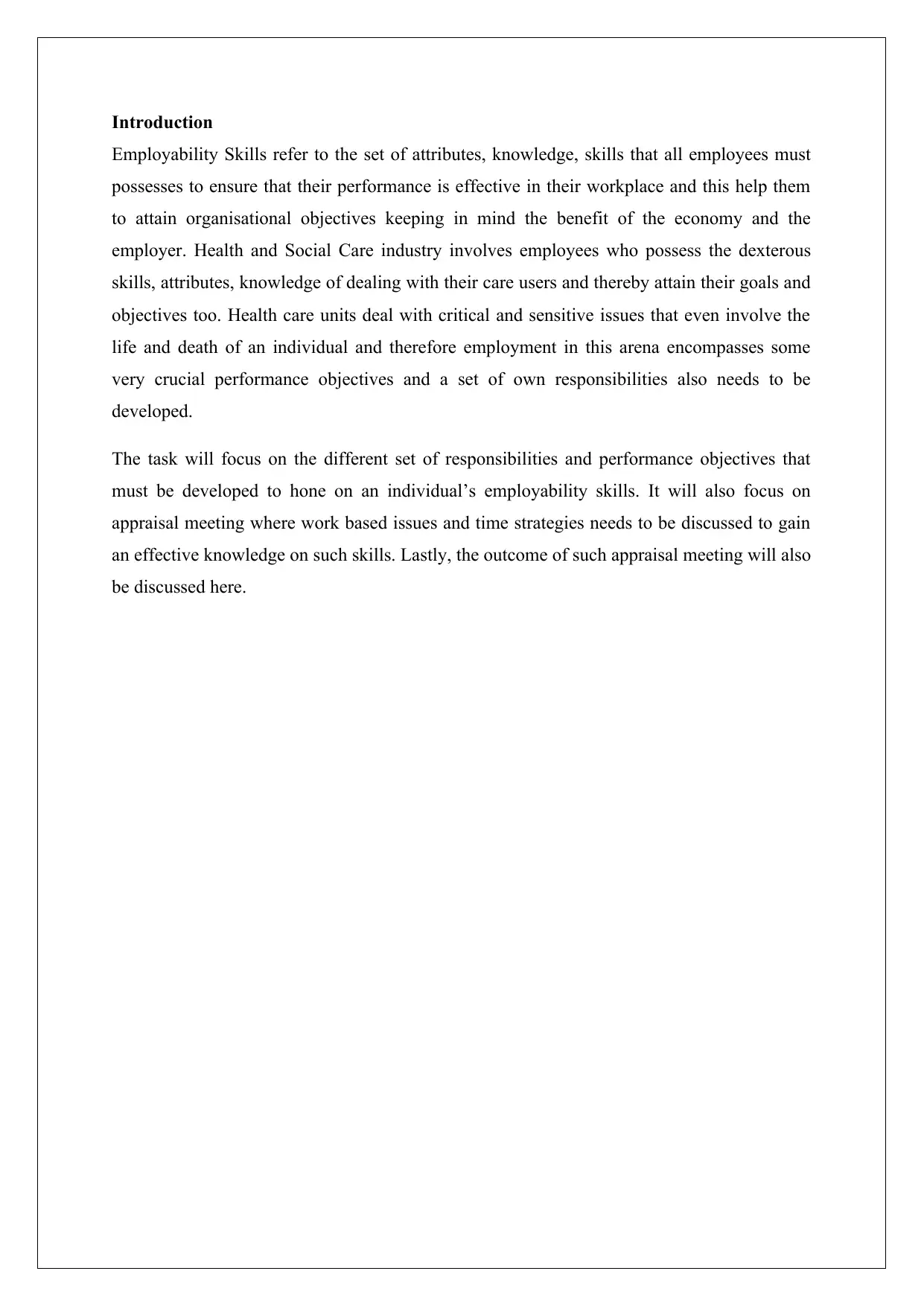
Introduction
Employability Skills refer to the set of attributes, knowledge, skills that all employees must
possesses to ensure that their performance is effective in their workplace and this help them
to attain organisational objectives keeping in mind the benefit of the economy and the
employer. Health and Social Care industry involves employees who possess the dexterous
skills, attributes, knowledge of dealing with their care users and thereby attain their goals and
objectives too. Health care units deal with critical and sensitive issues that even involve the
life and death of an individual and therefore employment in this arena encompasses some
very crucial performance objectives and a set of own responsibilities also needs to be
developed.
The task will focus on the different set of responsibilities and performance objectives that
must be developed to hone on an individual’s employability skills. It will also focus on
appraisal meeting where work based issues and time strategies needs to be discussed to gain
an effective knowledge on such skills. Lastly, the outcome of such appraisal meeting will also
be discussed here.
Employability Skills refer to the set of attributes, knowledge, skills that all employees must
possesses to ensure that their performance is effective in their workplace and this help them
to attain organisational objectives keeping in mind the benefit of the economy and the
employer. Health and Social Care industry involves employees who possess the dexterous
skills, attributes, knowledge of dealing with their care users and thereby attain their goals and
objectives too. Health care units deal with critical and sensitive issues that even involve the
life and death of an individual and therefore employment in this arena encompasses some
very crucial performance objectives and a set of own responsibilities also needs to be
developed.
The task will focus on the different set of responsibilities and performance objectives that
must be developed to hone on an individual’s employability skills. It will also focus on
appraisal meeting where work based issues and time strategies needs to be discussed to gain
an effective knowledge on such skills. Lastly, the outcome of such appraisal meeting will also
be discussed here.
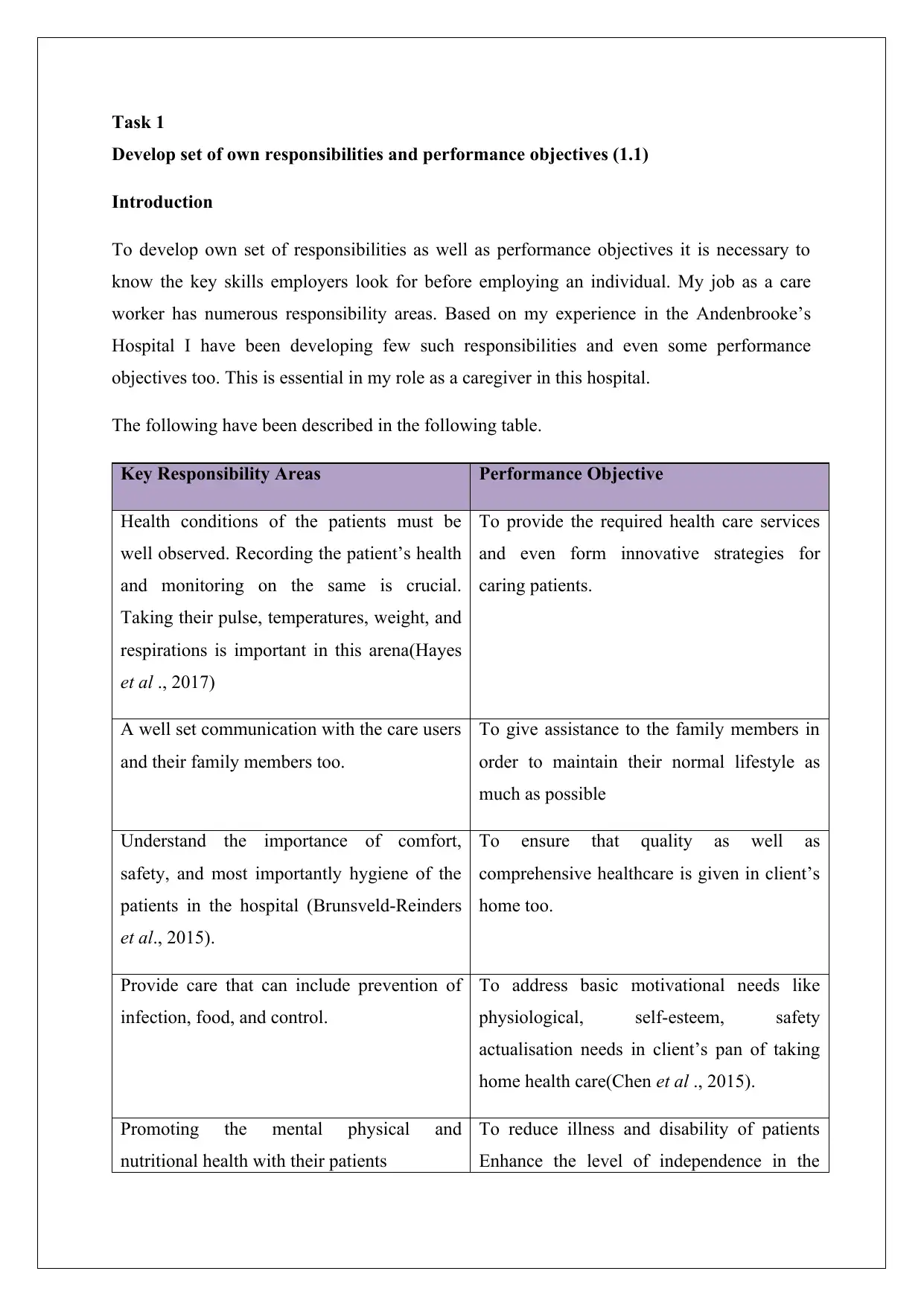
Task 1
Develop set of own responsibilities and performance objectives (1.1)
Introduction
To develop own set of responsibilities as well as performance objectives it is necessary to
know the key skills employers look for before employing an individual. My job as a care
worker has numerous responsibility areas. Based on my experience in the Andenbrooke’s
Hospital I have been developing few such responsibilities and even some performance
objectives too. This is essential in my role as a caregiver in this hospital.
The following have been described in the following table.
Key Responsibility Areas Performance Objective
Health conditions of the patients must be
well observed. Recording the patient’s health
and monitoring on the same is crucial.
Taking their pulse, temperatures, weight, and
respirations is important in this arena(Hayes
et al ., 2017)
To provide the required health care services
and even form innovative strategies for
caring patients.
A well set communication with the care users
and their family members too.
To give assistance to the family members in
order to maintain their normal lifestyle as
much as possible
Understand the importance of comfort,
safety, and most importantly hygiene of the
patients in the hospital (Brunsveld-Reinders
et al., 2015).
To ensure that quality as well as
comprehensive healthcare is given in client’s
home too.
Provide care that can include prevention of
infection, food, and control.
To address basic motivational needs like
physiological, self-esteem, safety
actualisation needs in client’s pan of taking
home health care(Chen et al ., 2015).
Promoting the mental physical and
nutritional health with their patients
To reduce illness and disability of patients
Enhance the level of independence in the
Develop set of own responsibilities and performance objectives (1.1)
Introduction
To develop own set of responsibilities as well as performance objectives it is necessary to
know the key skills employers look for before employing an individual. My job as a care
worker has numerous responsibility areas. Based on my experience in the Andenbrooke’s
Hospital I have been developing few such responsibilities and even some performance
objectives too. This is essential in my role as a caregiver in this hospital.
The following have been described in the following table.
Key Responsibility Areas Performance Objective
Health conditions of the patients must be
well observed. Recording the patient’s health
and monitoring on the same is crucial.
Taking their pulse, temperatures, weight, and
respirations is important in this arena(Hayes
et al ., 2017)
To provide the required health care services
and even form innovative strategies for
caring patients.
A well set communication with the care users
and their family members too.
To give assistance to the family members in
order to maintain their normal lifestyle as
much as possible
Understand the importance of comfort,
safety, and most importantly hygiene of the
patients in the hospital (Brunsveld-Reinders
et al., 2015).
To ensure that quality as well as
comprehensive healthcare is given in client’s
home too.
Provide care that can include prevention of
infection, food, and control.
To address basic motivational needs like
physiological, self-esteem, safety
actualisation needs in client’s pan of taking
home health care(Chen et al ., 2015).
Promoting the mental physical and
nutritional health with their patients
To reduce illness and disability of patients
Enhance the level of independence in the
Secure Best Marks with AI Grader
Need help grading? Try our AI Grader for instant feedback on your assignments.
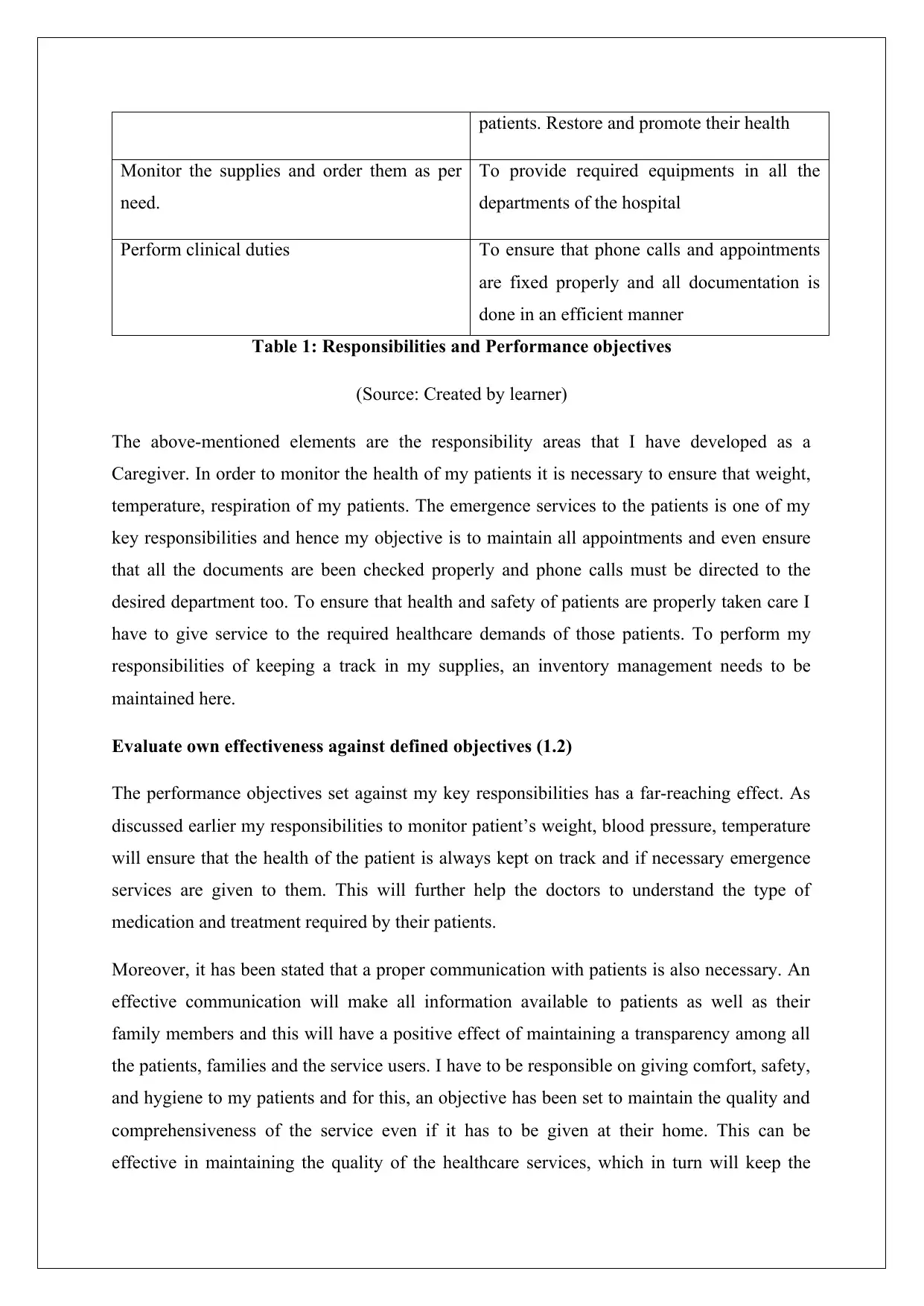
patients. Restore and promote their health
Monitor the supplies and order them as per
need.
To provide required equipments in all the
departments of the hospital
Perform clinical duties To ensure that phone calls and appointments
are fixed properly and all documentation is
done in an efficient manner
Table 1: Responsibilities and Performance objectives
(Source: Created by learner)
The above-mentioned elements are the responsibility areas that I have developed as a
Caregiver. In order to monitor the health of my patients it is necessary to ensure that weight,
temperature, respiration of my patients. The emergence services to the patients is one of my
key responsibilities and hence my objective is to maintain all appointments and even ensure
that all the documents are been checked properly and phone calls must be directed to the
desired department too. To ensure that health and safety of patients are properly taken care I
have to give service to the required healthcare demands of those patients. To perform my
responsibilities of keeping a track in my supplies, an inventory management needs to be
maintained here.
Evaluate own effectiveness against defined objectives (1.2)
The performance objectives set against my key responsibilities has a far-reaching effect. As
discussed earlier my responsibilities to monitor patient’s weight, blood pressure, temperature
will ensure that the health of the patient is always kept on track and if necessary emergence
services are given to them. This will further help the doctors to understand the type of
medication and treatment required by their patients.
Moreover, it has been stated that a proper communication with patients is also necessary. An
effective communication will make all information available to patients as well as their
family members and this will have a positive effect of maintaining a transparency among all
the patients, families and the service users. I have to be responsible on giving comfort, safety,
and hygiene to my patients and for this, an objective has been set to maintain the quality and
comprehensiveness of the service even if it has to be given at their home. This can be
effective in maintaining the quality of the healthcare services, which in turn will keep the
Monitor the supplies and order them as per
need.
To provide required equipments in all the
departments of the hospital
Perform clinical duties To ensure that phone calls and appointments
are fixed properly and all documentation is
done in an efficient manner
Table 1: Responsibilities and Performance objectives
(Source: Created by learner)
The above-mentioned elements are the responsibility areas that I have developed as a
Caregiver. In order to monitor the health of my patients it is necessary to ensure that weight,
temperature, respiration of my patients. The emergence services to the patients is one of my
key responsibilities and hence my objective is to maintain all appointments and even ensure
that all the documents are been checked properly and phone calls must be directed to the
desired department too. To ensure that health and safety of patients are properly taken care I
have to give service to the required healthcare demands of those patients. To perform my
responsibilities of keeping a track in my supplies, an inventory management needs to be
maintained here.
Evaluate own effectiveness against defined objectives (1.2)
The performance objectives set against my key responsibilities has a far-reaching effect. As
discussed earlier my responsibilities to monitor patient’s weight, blood pressure, temperature
will ensure that the health of the patient is always kept on track and if necessary emergence
services are given to them. This will further help the doctors to understand the type of
medication and treatment required by their patients.
Moreover, it has been stated that a proper communication with patients is also necessary. An
effective communication will make all information available to patients as well as their
family members and this will have a positive effect of maintaining a transparency among all
the patients, families and the service users. I have to be responsible on giving comfort, safety,
and hygiene to my patients and for this, an objective has been set to maintain the quality and
comprehensiveness of the service even if it has to be given at their home. This can be
effective in maintaining the quality of the healthcare services, which in turn will keep the
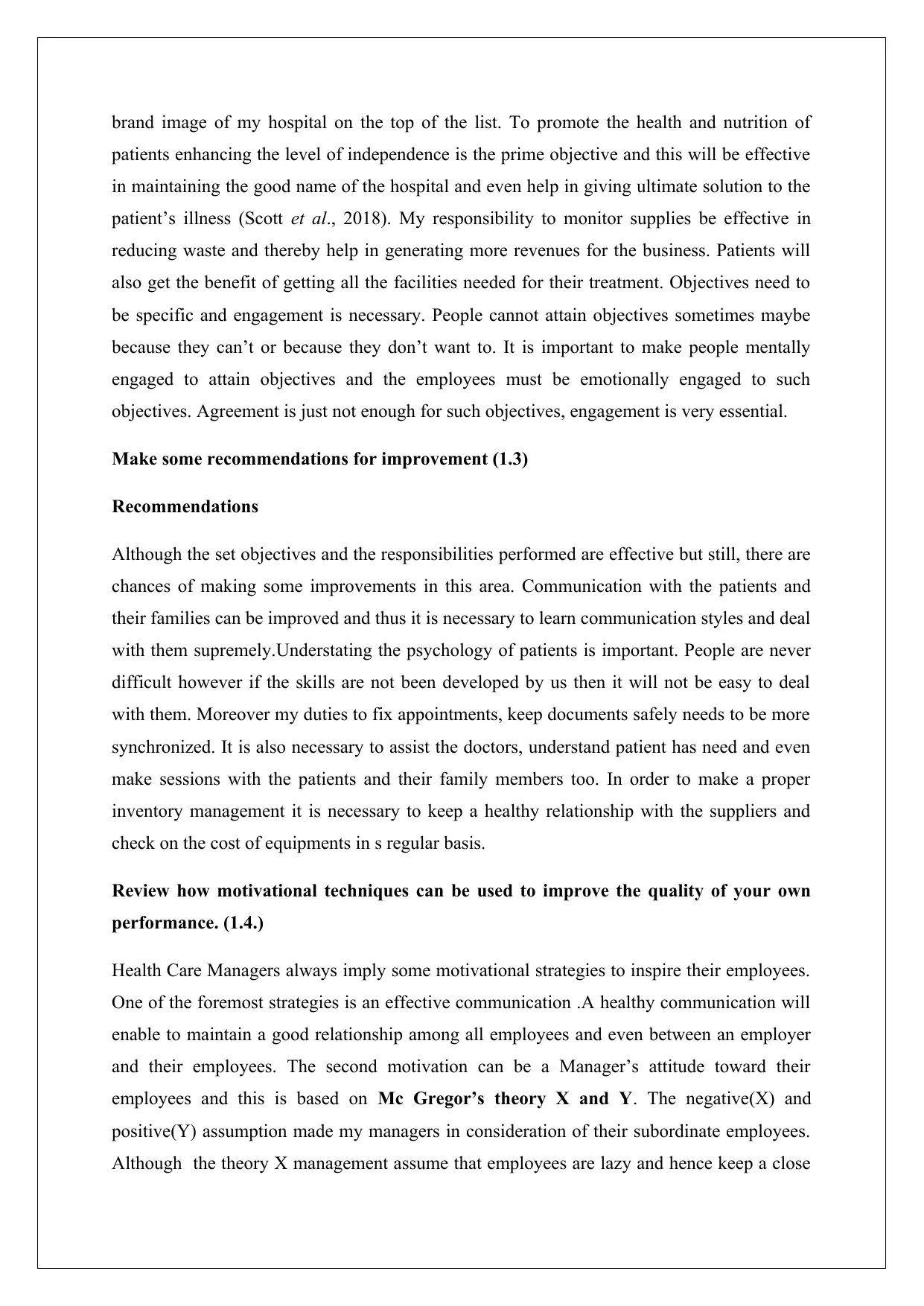
brand image of my hospital on the top of the list. To promote the health and nutrition of
patients enhancing the level of independence is the prime objective and this will be effective
in maintaining the good name of the hospital and even help in giving ultimate solution to the
patient’s illness (Scott et al., 2018). My responsibility to monitor supplies be effective in
reducing waste and thereby help in generating more revenues for the business. Patients will
also get the benefit of getting all the facilities needed for their treatment. Objectives need to
be specific and engagement is necessary. People cannot attain objectives sometimes maybe
because they can’t or because they don’t want to. It is important to make people mentally
engaged to attain objectives and the employees must be emotionally engaged to such
objectives. Agreement is just not enough for such objectives, engagement is very essential.
Make some recommendations for improvement (1.3)
Recommendations
Although the set objectives and the responsibilities performed are effective but still, there are
chances of making some improvements in this area. Communication with the patients and
their families can be improved and thus it is necessary to learn communication styles and deal
with them supremely.Understating the psychology of patients is important. People are never
difficult however if the skills are not been developed by us then it will not be easy to deal
with them. Moreover my duties to fix appointments, keep documents safely needs to be more
synchronized. It is also necessary to assist the doctors, understand patient has need and even
make sessions with the patients and their family members too. In order to make a proper
inventory management it is necessary to keep a healthy relationship with the suppliers and
check on the cost of equipments in s regular basis.
Review how motivational techniques can be used to improve the quality of your own
performance. (1.4.)
Health Care Managers always imply some motivational strategies to inspire their employees.
One of the foremost strategies is an effective communication .A healthy communication will
enable to maintain a good relationship among all employees and even between an employer
and their employees. The second motivation can be a Manager’s attitude toward their
employees and this is based on Mc Gregor’s theory X and Y. The negative(X) and
positive(Y) assumption made my managers in consideration of their subordinate employees.
Although the theory X management assume that employees are lazy and hence keep a close
patients enhancing the level of independence is the prime objective and this will be effective
in maintaining the good name of the hospital and even help in giving ultimate solution to the
patient’s illness (Scott et al., 2018). My responsibility to monitor supplies be effective in
reducing waste and thereby help in generating more revenues for the business. Patients will
also get the benefit of getting all the facilities needed for their treatment. Objectives need to
be specific and engagement is necessary. People cannot attain objectives sometimes maybe
because they can’t or because they don’t want to. It is important to make people mentally
engaged to attain objectives and the employees must be emotionally engaged to such
objectives. Agreement is just not enough for such objectives, engagement is very essential.
Make some recommendations for improvement (1.3)
Recommendations
Although the set objectives and the responsibilities performed are effective but still, there are
chances of making some improvements in this area. Communication with the patients and
their families can be improved and thus it is necessary to learn communication styles and deal
with them supremely.Understating the psychology of patients is important. People are never
difficult however if the skills are not been developed by us then it will not be easy to deal
with them. Moreover my duties to fix appointments, keep documents safely needs to be more
synchronized. It is also necessary to assist the doctors, understand patient has need and even
make sessions with the patients and their family members too. In order to make a proper
inventory management it is necessary to keep a healthy relationship with the suppliers and
check on the cost of equipments in s regular basis.
Review how motivational techniques can be used to improve the quality of your own
performance. (1.4.)
Health Care Managers always imply some motivational strategies to inspire their employees.
One of the foremost strategies is an effective communication .A healthy communication will
enable to maintain a good relationship among all employees and even between an employer
and their employees. The second motivation can be a Manager’s attitude toward their
employees and this is based on Mc Gregor’s theory X and Y. The negative(X) and
positive(Y) assumption made my managers in consideration of their subordinate employees.
Although the theory X management assume that employees are lazy and hence keep a close
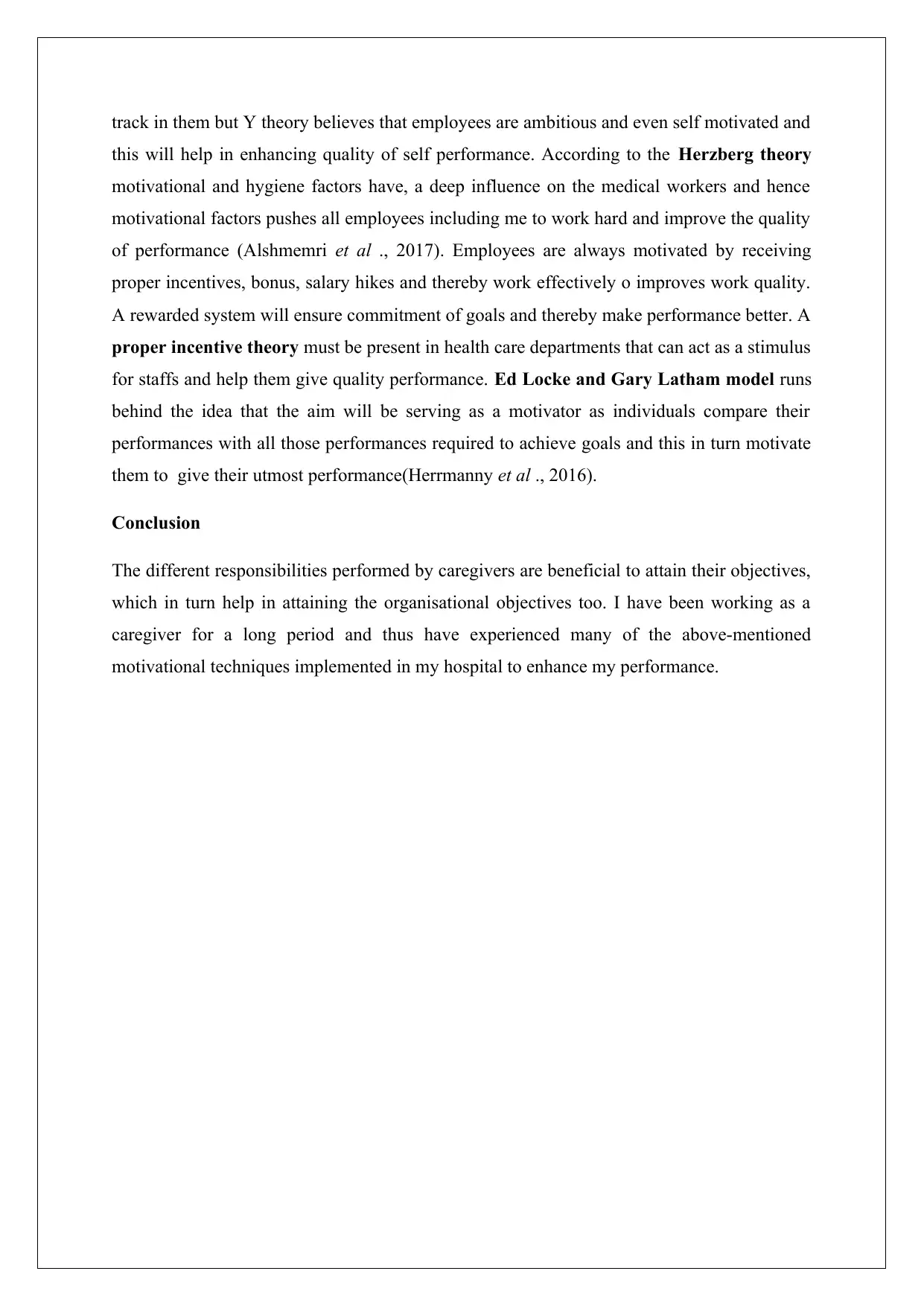
track in them but Y theory believes that employees are ambitious and even self motivated and
this will help in enhancing quality of self performance. According to the Herzberg theory
motivational and hygiene factors have, a deep influence on the medical workers and hence
motivational factors pushes all employees including me to work hard and improve the quality
of performance (Alshmemri et al ., 2017). Employees are always motivated by receiving
proper incentives, bonus, salary hikes and thereby work effectively o improves work quality.
A rewarded system will ensure commitment of goals and thereby make performance better. A
proper incentive theory must be present in health care departments that can act as a stimulus
for staffs and help them give quality performance. Ed Locke and Gary Latham model runs
behind the idea that the aim will be serving as a motivator as individuals compare their
performances with all those performances required to achieve goals and this in turn motivate
them to give their utmost performance(Herrmanny et al ., 2016).
Conclusion
The different responsibilities performed by caregivers are beneficial to attain their objectives,
which in turn help in attaining the organisational objectives too. I have been working as a
caregiver for a long period and thus have experienced many of the above-mentioned
motivational techniques implemented in my hospital to enhance my performance.
this will help in enhancing quality of self performance. According to the Herzberg theory
motivational and hygiene factors have, a deep influence on the medical workers and hence
motivational factors pushes all employees including me to work hard and improve the quality
of performance (Alshmemri et al ., 2017). Employees are always motivated by receiving
proper incentives, bonus, salary hikes and thereby work effectively o improves work quality.
A rewarded system will ensure commitment of goals and thereby make performance better. A
proper incentive theory must be present in health care departments that can act as a stimulus
for staffs and help them give quality performance. Ed Locke and Gary Latham model runs
behind the idea that the aim will be serving as a motivator as individuals compare their
performances with all those performances required to achieve goals and this in turn motivate
them to give their utmost performance(Herrmanny et al ., 2016).
Conclusion
The different responsibilities performed by caregivers are beneficial to attain their objectives,
which in turn help in attaining the organisational objectives too. I have been working as a
caregiver for a long period and thus have experienced many of the above-mentioned
motivational techniques implemented in my hospital to enhance my performance.
Paraphrase This Document
Need a fresh take? Get an instant paraphrase of this document with our AI Paraphraser
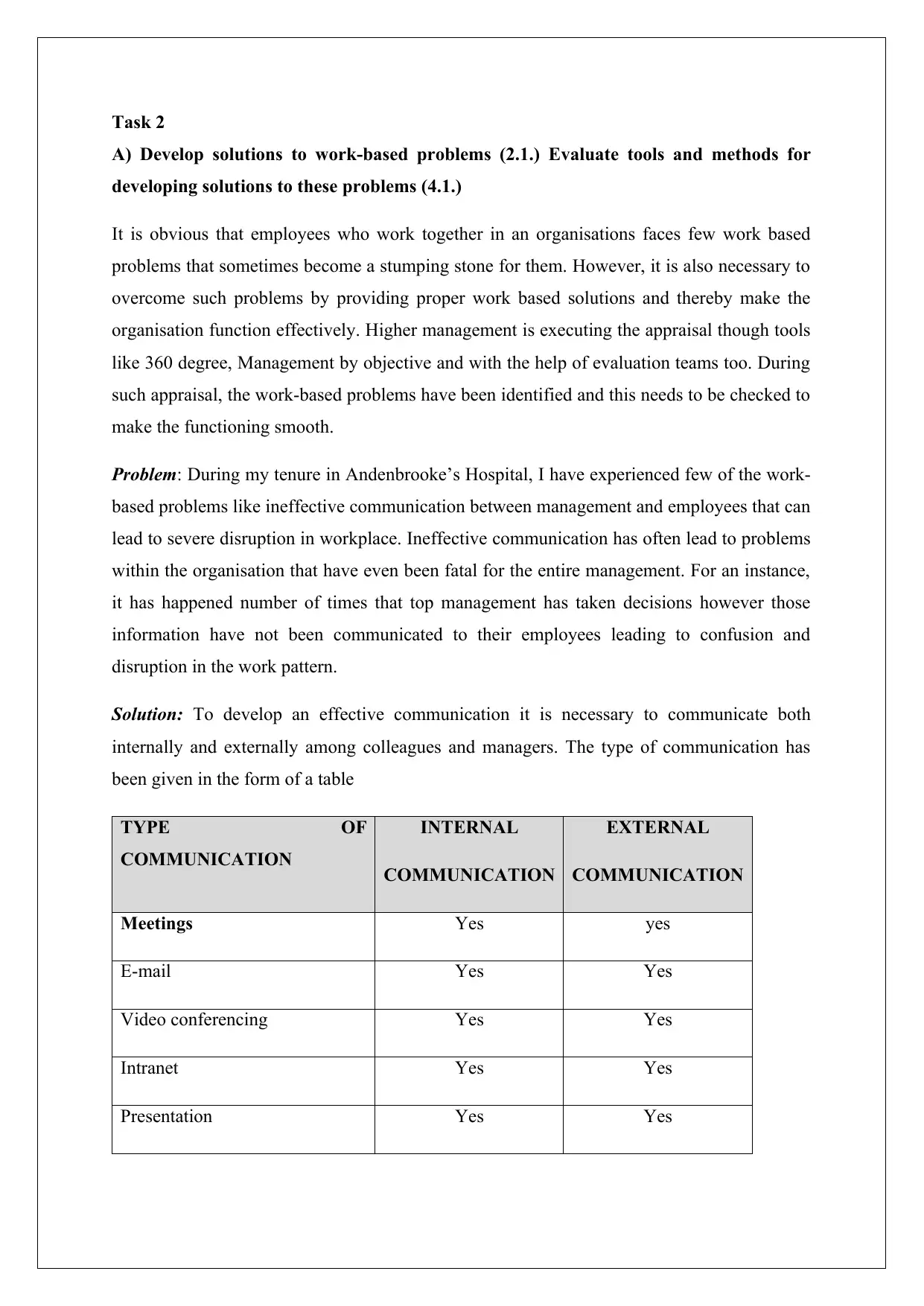
Task 2
A) Develop solutions to work-based problems (2.1.) Evaluate tools and methods for
developing solutions to these problems (4.1.)
It is obvious that employees who work together in an organisations faces few work based
problems that sometimes become a stumping stone for them. However, it is also necessary to
overcome such problems by providing proper work based solutions and thereby make the
organisation function effectively. Higher management is executing the appraisal though tools
like 360 degree, Management by objective and with the help of evaluation teams too. During
such appraisal, the work-based problems have been identified and this needs to be checked to
make the functioning smooth.
Problem: During my tenure in Andenbrooke’s Hospital, I have experienced few of the work-
based problems like ineffective communication between management and employees that can
lead to severe disruption in workplace. Ineffective communication has often lead to problems
within the organisation that have even been fatal for the entire management. For an instance,
it has happened number of times that top management has taken decisions however those
information have not been communicated to their employees leading to confusion and
disruption in the work pattern.
Solution: To develop an effective communication it is necessary to communicate both
internally and externally among colleagues and managers. The type of communication has
been given in the form of a table
TYPE OF
COMMUNICATION
INTERNAL
COMMUNICATION
EXTERNAL
COMMUNICATION
Meetings Yes yes
E-mail Yes Yes
Video conferencing Yes Yes
Intranet Yes Yes
Presentation Yes Yes
A) Develop solutions to work-based problems (2.1.) Evaluate tools and methods for
developing solutions to these problems (4.1.)
It is obvious that employees who work together in an organisations faces few work based
problems that sometimes become a stumping stone for them. However, it is also necessary to
overcome such problems by providing proper work based solutions and thereby make the
organisation function effectively. Higher management is executing the appraisal though tools
like 360 degree, Management by objective and with the help of evaluation teams too. During
such appraisal, the work-based problems have been identified and this needs to be checked to
make the functioning smooth.
Problem: During my tenure in Andenbrooke’s Hospital, I have experienced few of the work-
based problems like ineffective communication between management and employees that can
lead to severe disruption in workplace. Ineffective communication has often lead to problems
within the organisation that have even been fatal for the entire management. For an instance,
it has happened number of times that top management has taken decisions however those
information have not been communicated to their employees leading to confusion and
disruption in the work pattern.
Solution: To develop an effective communication it is necessary to communicate both
internally and externally among colleagues and managers. The type of communication has
been given in the form of a table
TYPE OF
COMMUNICATION
INTERNAL
COMMUNICATION
EXTERNAL
COMMUNICATION
Meetings Yes yes
E-mail Yes Yes
Video conferencing Yes Yes
Intranet Yes Yes
Presentation Yes Yes
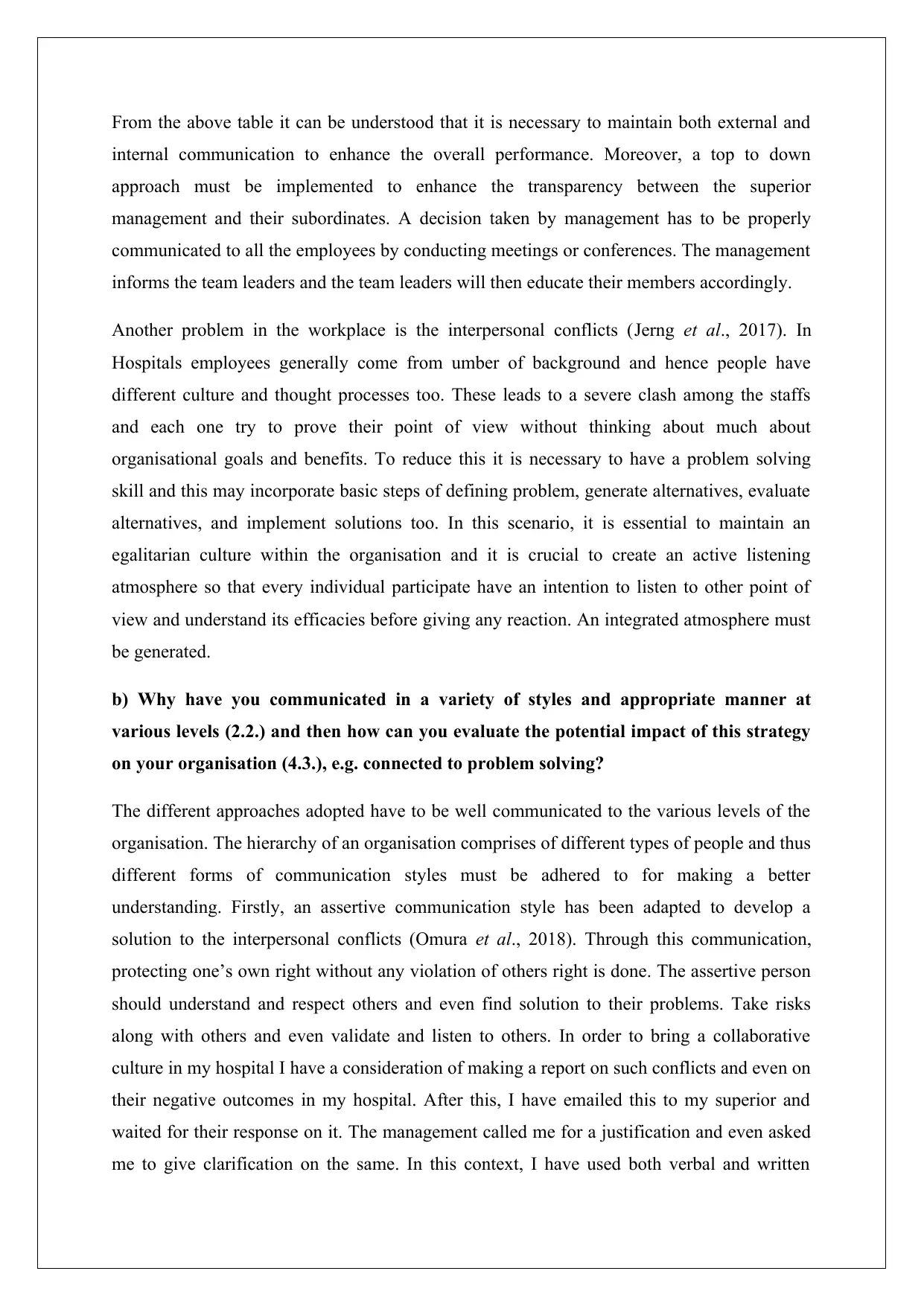
From the above table it can be understood that it is necessary to maintain both external and
internal communication to enhance the overall performance. Moreover, a top to down
approach must be implemented to enhance the transparency between the superior
management and their subordinates. A decision taken by management has to be properly
communicated to all the employees by conducting meetings or conferences. The management
informs the team leaders and the team leaders will then educate their members accordingly.
Another problem in the workplace is the interpersonal conflicts (Jerng et al., 2017). In
Hospitals employees generally come from umber of background and hence people have
different culture and thought processes too. These leads to a severe clash among the staffs
and each one try to prove their point of view without thinking about much about
organisational goals and benefits. To reduce this it is necessary to have a problem solving
skill and this may incorporate basic steps of defining problem, generate alternatives, evaluate
alternatives, and implement solutions too. In this scenario, it is essential to maintain an
egalitarian culture within the organisation and it is crucial to create an active listening
atmosphere so that every individual participate have an intention to listen to other point of
view and understand its efficacies before giving any reaction. An integrated atmosphere must
be generated.
b) Why have you communicated in a variety of styles and appropriate manner at
various levels (2.2.) and then how can you evaluate the potential impact of this strategy
on your organisation (4.3.), e.g. connected to problem solving?
The different approaches adopted have to be well communicated to the various levels of the
organisation. The hierarchy of an organisation comprises of different types of people and thus
different forms of communication styles must be adhered to for making a better
understanding. Firstly, an assertive communication style has been adapted to develop a
solution to the interpersonal conflicts (Omura et al., 2018). Through this communication,
protecting one’s own right without any violation of others right is done. The assertive person
should understand and respect others and even find solution to their problems. Take risks
along with others and even validate and listen to others. In order to bring a collaborative
culture in my hospital I have a consideration of making a report on such conflicts and even on
their negative outcomes in my hospital. After this, I have emailed this to my superior and
waited for their response on it. The management called me for a justification and even asked
me to give clarification on the same. In this context, I have used both verbal and written
internal communication to enhance the overall performance. Moreover, a top to down
approach must be implemented to enhance the transparency between the superior
management and their subordinates. A decision taken by management has to be properly
communicated to all the employees by conducting meetings or conferences. The management
informs the team leaders and the team leaders will then educate their members accordingly.
Another problem in the workplace is the interpersonal conflicts (Jerng et al., 2017). In
Hospitals employees generally come from umber of background and hence people have
different culture and thought processes too. These leads to a severe clash among the staffs
and each one try to prove their point of view without thinking about much about
organisational goals and benefits. To reduce this it is necessary to have a problem solving
skill and this may incorporate basic steps of defining problem, generate alternatives, evaluate
alternatives, and implement solutions too. In this scenario, it is essential to maintain an
egalitarian culture within the organisation and it is crucial to create an active listening
atmosphere so that every individual participate have an intention to listen to other point of
view and understand its efficacies before giving any reaction. An integrated atmosphere must
be generated.
b) Why have you communicated in a variety of styles and appropriate manner at
various levels (2.2.) and then how can you evaluate the potential impact of this strategy
on your organisation (4.3.), e.g. connected to problem solving?
The different approaches adopted have to be well communicated to the various levels of the
organisation. The hierarchy of an organisation comprises of different types of people and thus
different forms of communication styles must be adhered to for making a better
understanding. Firstly, an assertive communication style has been adapted to develop a
solution to the interpersonal conflicts (Omura et al., 2018). Through this communication,
protecting one’s own right without any violation of others right is done. The assertive person
should understand and respect others and even find solution to their problems. Take risks
along with others and even validate and listen to others. In order to bring a collaborative
culture in my hospital I have a consideration of making a report on such conflicts and even on
their negative outcomes in my hospital. After this, I have emailed this to my superior and
waited for their response on it. The management called me for a justification and even asked
me to give clarification on the same. In this context, I have used both verbal and written
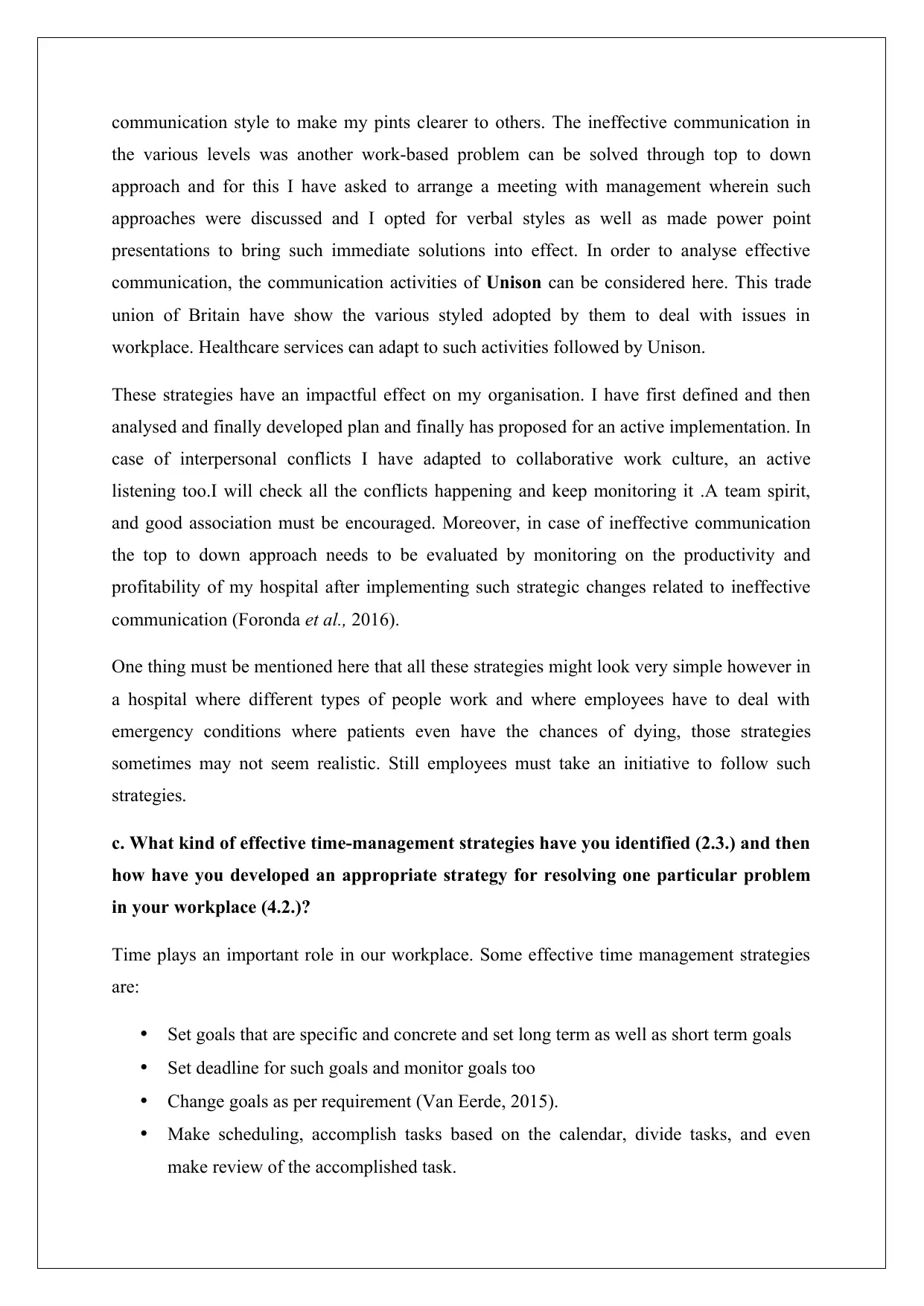
communication style to make my pints clearer to others. The ineffective communication in
the various levels was another work-based problem can be solved through top to down
approach and for this I have asked to arrange a meeting with management wherein such
approaches were discussed and I opted for verbal styles as well as made power point
presentations to bring such immediate solutions into effect. In order to analyse effective
communication, the communication activities of Unison can be considered here. This trade
union of Britain have show the various styled adopted by them to deal with issues in
workplace. Healthcare services can adapt to such activities followed by Unison.
These strategies have an impactful effect on my organisation. I have first defined and then
analysed and finally developed plan and finally has proposed for an active implementation. In
case of interpersonal conflicts I have adapted to collaborative work culture, an active
listening too.I will check all the conflicts happening and keep monitoring it .A team spirit,
and good association must be encouraged. Moreover, in case of ineffective communication
the top to down approach needs to be evaluated by monitoring on the productivity and
profitability of my hospital after implementing such strategic changes related to ineffective
communication (Foronda et al., 2016).
One thing must be mentioned here that all these strategies might look very simple however in
a hospital where different types of people work and where employees have to deal with
emergency conditions where patients even have the chances of dying, those strategies
sometimes may not seem realistic. Still employees must take an initiative to follow such
strategies.
c. What kind of effective time-management strategies have you identified (2.3.) and then
how have you developed an appropriate strategy for resolving one particular problem
in your workplace (4.2.)?
Time plays an important role in our workplace. Some effective time management strategies
are:
Set goals that are specific and concrete and set long term as well as short term goals
Set deadline for such goals and monitor goals too
Change goals as per requirement (Van Eerde, 2015).
Make scheduling, accomplish tasks based on the calendar, divide tasks, and even
make review of the accomplished task.
the various levels was another work-based problem can be solved through top to down
approach and for this I have asked to arrange a meeting with management wherein such
approaches were discussed and I opted for verbal styles as well as made power point
presentations to bring such immediate solutions into effect. In order to analyse effective
communication, the communication activities of Unison can be considered here. This trade
union of Britain have show the various styled adopted by them to deal with issues in
workplace. Healthcare services can adapt to such activities followed by Unison.
These strategies have an impactful effect on my organisation. I have first defined and then
analysed and finally developed plan and finally has proposed for an active implementation. In
case of interpersonal conflicts I have adapted to collaborative work culture, an active
listening too.I will check all the conflicts happening and keep monitoring it .A team spirit,
and good association must be encouraged. Moreover, in case of ineffective communication
the top to down approach needs to be evaluated by monitoring on the productivity and
profitability of my hospital after implementing such strategic changes related to ineffective
communication (Foronda et al., 2016).
One thing must be mentioned here that all these strategies might look very simple however in
a hospital where different types of people work and where employees have to deal with
emergency conditions where patients even have the chances of dying, those strategies
sometimes may not seem realistic. Still employees must take an initiative to follow such
strategies.
c. What kind of effective time-management strategies have you identified (2.3.) and then
how have you developed an appropriate strategy for resolving one particular problem
in your workplace (4.2.)?
Time plays an important role in our workplace. Some effective time management strategies
are:
Set goals that are specific and concrete and set long term as well as short term goals
Set deadline for such goals and monitor goals too
Change goals as per requirement (Van Eerde, 2015).
Make scheduling, accomplish tasks based on the calendar, divide tasks, and even
make review of the accomplished task.
Secure Best Marks with AI Grader
Need help grading? Try our AI Grader for instant feedback on your assignments.
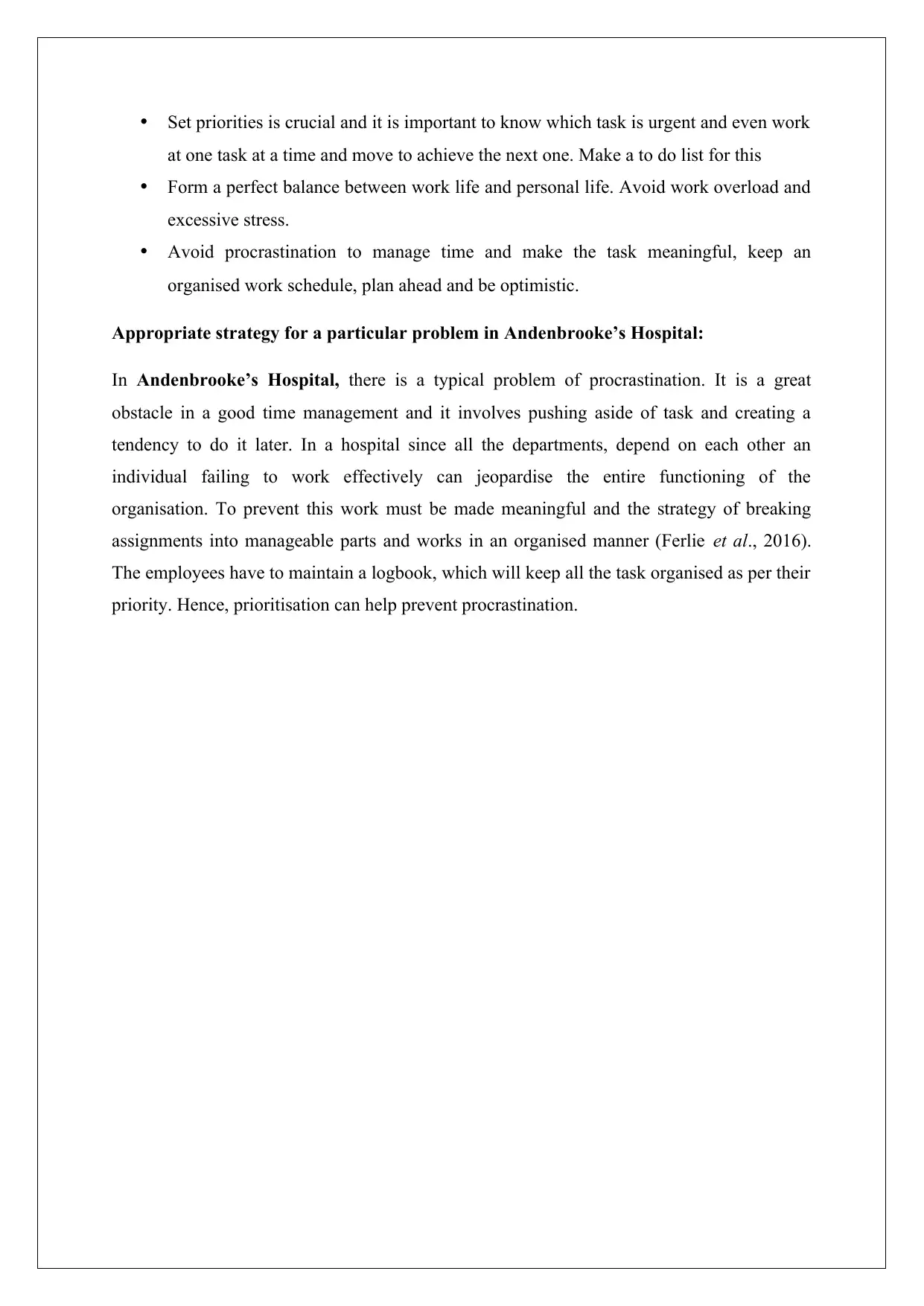
Set priorities is crucial and it is important to know which task is urgent and even work
at one task at a time and move to achieve the next one. Make a to do list for this
Form a perfect balance between work life and personal life. Avoid work overload and
excessive stress.
Avoid procrastination to manage time and make the task meaningful, keep an
organised work schedule, plan ahead and be optimistic.
Appropriate strategy for a particular problem in Andenbrooke’s Hospital:
In Andenbrooke’s Hospital, there is a typical problem of procrastination. It is a great
obstacle in a good time management and it involves pushing aside of task and creating a
tendency to do it later. In a hospital since all the departments, depend on each other an
individual failing to work effectively can jeopardise the entire functioning of the
organisation. To prevent this work must be made meaningful and the strategy of breaking
assignments into manageable parts and works in an organised manner (Ferlie et al., 2016).
The employees have to maintain a logbook, which will keep all the task organised as per their
priority. Hence, prioritisation can help prevent procrastination.
at one task at a time and move to achieve the next one. Make a to do list for this
Form a perfect balance between work life and personal life. Avoid work overload and
excessive stress.
Avoid procrastination to manage time and make the task meaningful, keep an
organised work schedule, plan ahead and be optimistic.
Appropriate strategy for a particular problem in Andenbrooke’s Hospital:
In Andenbrooke’s Hospital, there is a typical problem of procrastination. It is a great
obstacle in a good time management and it involves pushing aside of task and creating a
tendency to do it later. In a hospital since all the departments, depend on each other an
individual failing to work effectively can jeopardise the entire functioning of the
organisation. To prevent this work must be made meaningful and the strategy of breaking
assignments into manageable parts and works in an organised manner (Ferlie et al., 2016).
The employees have to maintain a logbook, which will keep all the task organised as per their
priority. Hence, prioritisation can help prevent procrastination.
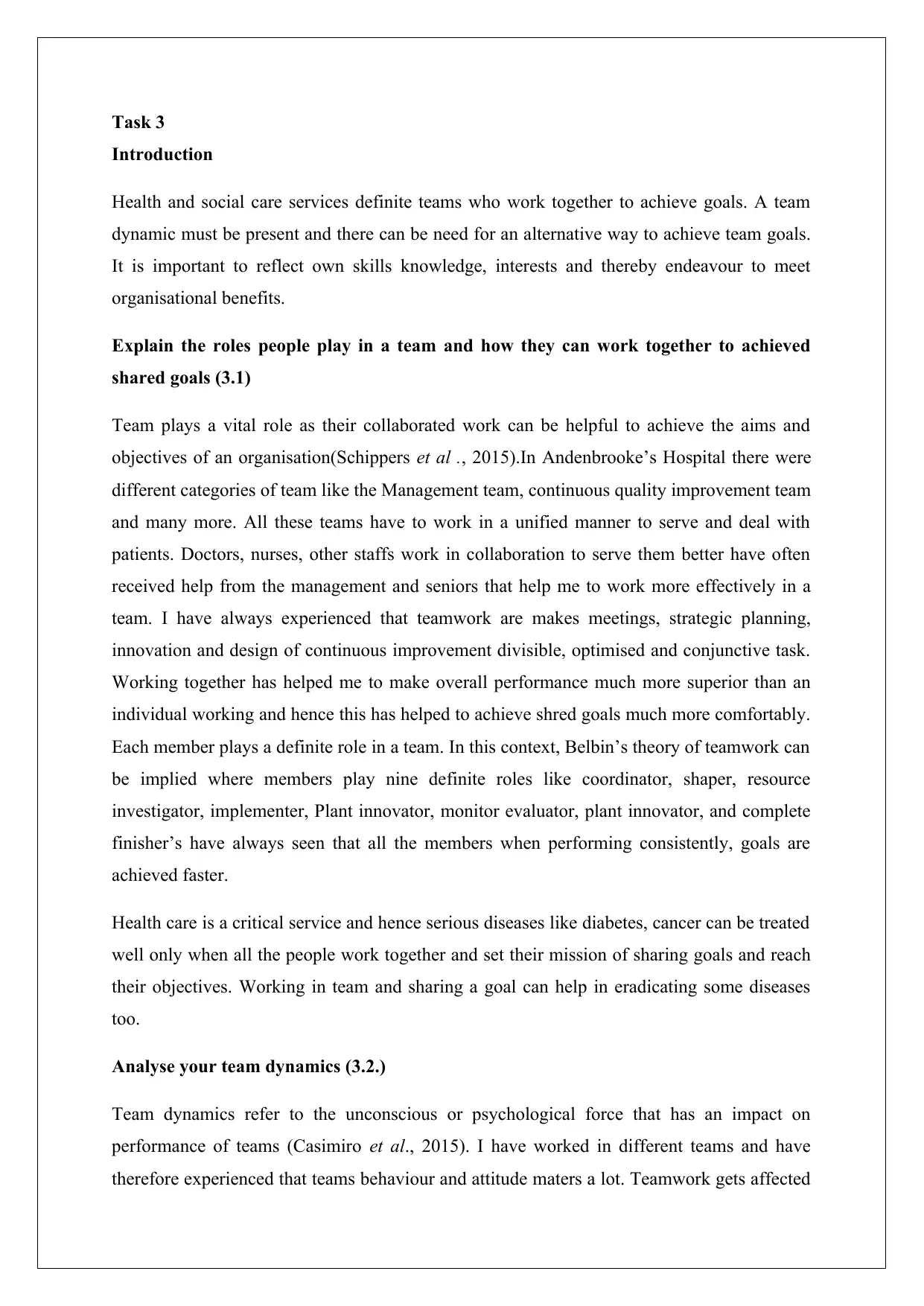
Task 3
Introduction
Health and social care services definite teams who work together to achieve goals. A team
dynamic must be present and there can be need for an alternative way to achieve team goals.
It is important to reflect own skills knowledge, interests and thereby endeavour to meet
organisational benefits.
Explain the roles people play in a team and how they can work together to achieved
shared goals (3.1)
Team plays a vital role as their collaborated work can be helpful to achieve the aims and
objectives of an organisation(Schippers et al ., 2015).In Andenbrooke’s Hospital there were
different categories of team like the Management team, continuous quality improvement team
and many more. All these teams have to work in a unified manner to serve and deal with
patients. Doctors, nurses, other staffs work in collaboration to serve them better have often
received help from the management and seniors that help me to work more effectively in a
team. I have always experienced that teamwork are makes meetings, strategic planning,
innovation and design of continuous improvement divisible, optimised and conjunctive task.
Working together has helped me to make overall performance much more superior than an
individual working and hence this has helped to achieve shred goals much more comfortably.
Each member plays a definite role in a team. In this context, Belbin’s theory of teamwork can
be implied where members play nine definite roles like coordinator, shaper, resource
investigator, implementer, Plant innovator, monitor evaluator, plant innovator, and complete
finisher’s have always seen that all the members when performing consistently, goals are
achieved faster.
Health care is a critical service and hence serious diseases like diabetes, cancer can be treated
well only when all the people work together and set their mission of sharing goals and reach
their objectives. Working in team and sharing a goal can help in eradicating some diseases
too.
Analyse your team dynamics (3.2.)
Team dynamics refer to the unconscious or psychological force that has an impact on
performance of teams (Casimiro et al., 2015). I have worked in different teams and have
therefore experienced that teams behaviour and attitude maters a lot. Teamwork gets affected
Introduction
Health and social care services definite teams who work together to achieve goals. A team
dynamic must be present and there can be need for an alternative way to achieve team goals.
It is important to reflect own skills knowledge, interests and thereby endeavour to meet
organisational benefits.
Explain the roles people play in a team and how they can work together to achieved
shared goals (3.1)
Team plays a vital role as their collaborated work can be helpful to achieve the aims and
objectives of an organisation(Schippers et al ., 2015).In Andenbrooke’s Hospital there were
different categories of team like the Management team, continuous quality improvement team
and many more. All these teams have to work in a unified manner to serve and deal with
patients. Doctors, nurses, other staffs work in collaboration to serve them better have often
received help from the management and seniors that help me to work more effectively in a
team. I have always experienced that teamwork are makes meetings, strategic planning,
innovation and design of continuous improvement divisible, optimised and conjunctive task.
Working together has helped me to make overall performance much more superior than an
individual working and hence this has helped to achieve shred goals much more comfortably.
Each member plays a definite role in a team. In this context, Belbin’s theory of teamwork can
be implied where members play nine definite roles like coordinator, shaper, resource
investigator, implementer, Plant innovator, monitor evaluator, plant innovator, and complete
finisher’s have always seen that all the members when performing consistently, goals are
achieved faster.
Health care is a critical service and hence serious diseases like diabetes, cancer can be treated
well only when all the people work together and set their mission of sharing goals and reach
their objectives. Working in team and sharing a goal can help in eradicating some diseases
too.
Analyse your team dynamics (3.2.)
Team dynamics refer to the unconscious or psychological force that has an impact on
performance of teams (Casimiro et al., 2015). I have worked in different teams and have
therefore experienced that teams behaviour and attitude maters a lot. Teamwork gets affected
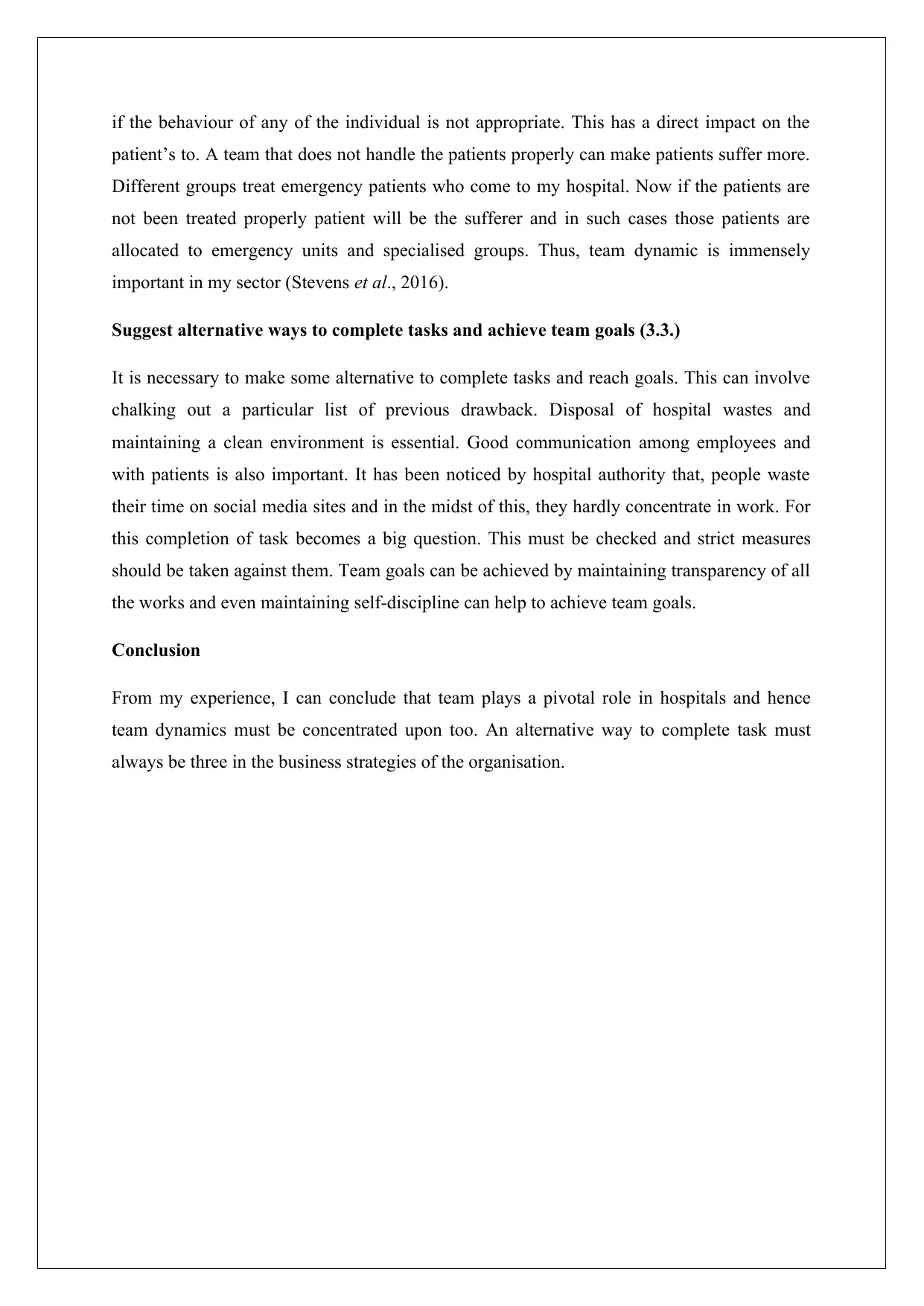
if the behaviour of any of the individual is not appropriate. This has a direct impact on the
patient’s to. A team that does not handle the patients properly can make patients suffer more.
Different groups treat emergency patients who come to my hospital. Now if the patients are
not been treated properly patient will be the sufferer and in such cases those patients are
allocated to emergency units and specialised groups. Thus, team dynamic is immensely
important in my sector (Stevens et al., 2016).
Suggest alternative ways to complete tasks and achieve team goals (3.3.)
It is necessary to make some alternative to complete tasks and reach goals. This can involve
chalking out a particular list of previous drawback. Disposal of hospital wastes and
maintaining a clean environment is essential. Good communication among employees and
with patients is also important. It has been noticed by hospital authority that, people waste
their time on social media sites and in the midst of this, they hardly concentrate in work. For
this completion of task becomes a big question. This must be checked and strict measures
should be taken against them. Team goals can be achieved by maintaining transparency of all
the works and even maintaining self-discipline can help to achieve team goals.
Conclusion
From my experience, I can conclude that team plays a pivotal role in hospitals and hence
team dynamics must be concentrated upon too. An alternative way to complete task must
always be three in the business strategies of the organisation.
patient’s to. A team that does not handle the patients properly can make patients suffer more.
Different groups treat emergency patients who come to my hospital. Now if the patients are
not been treated properly patient will be the sufferer and in such cases those patients are
allocated to emergency units and specialised groups. Thus, team dynamic is immensely
important in my sector (Stevens et al., 2016).
Suggest alternative ways to complete tasks and achieve team goals (3.3.)
It is necessary to make some alternative to complete tasks and reach goals. This can involve
chalking out a particular list of previous drawback. Disposal of hospital wastes and
maintaining a clean environment is essential. Good communication among employees and
with patients is also important. It has been noticed by hospital authority that, people waste
their time on social media sites and in the midst of this, they hardly concentrate in work. For
this completion of task becomes a big question. This must be checked and strict measures
should be taken against them. Team goals can be achieved by maintaining transparency of all
the works and even maintaining self-discipline can help to achieve team goals.
Conclusion
From my experience, I can conclude that team plays a pivotal role in hospitals and hence
team dynamics must be concentrated upon too. An alternative way to complete task must
always be three in the business strategies of the organisation.
Paraphrase This Document
Need a fresh take? Get an instant paraphrase of this document with our AI Paraphraser
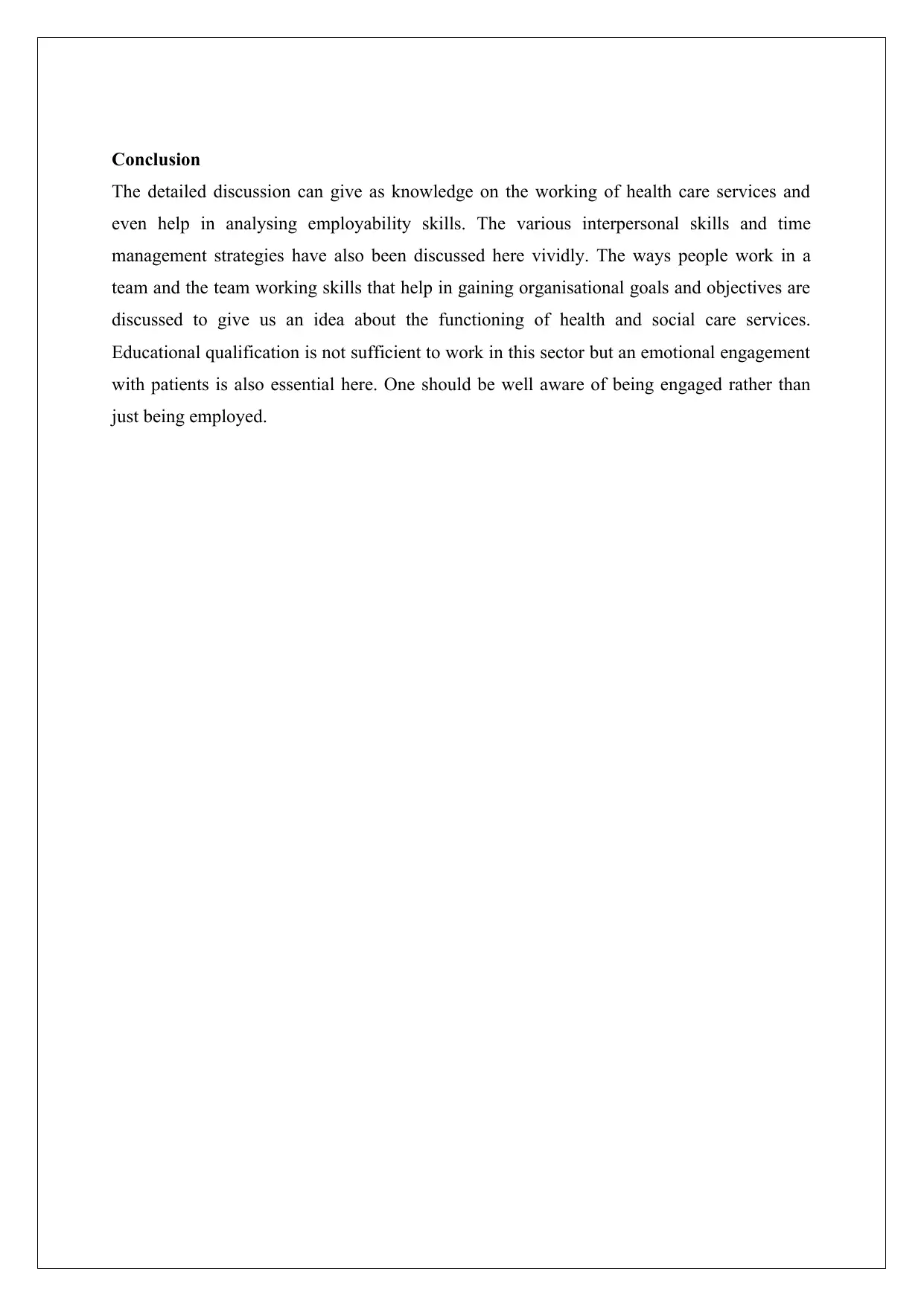
Conclusion
The detailed discussion can give as knowledge on the working of health care services and
even help in analysing employability skills. The various interpersonal skills and time
management strategies have also been discussed here vividly. The ways people work in a
team and the team working skills that help in gaining organisational goals and objectives are
discussed to give us an idea about the functioning of health and social care services.
Educational qualification is not sufficient to work in this sector but an emotional engagement
with patients is also essential here. One should be well aware of being engaged rather than
just being employed.
The detailed discussion can give as knowledge on the working of health care services and
even help in analysing employability skills. The various interpersonal skills and time
management strategies have also been discussed here vividly. The ways people work in a
team and the team working skills that help in gaining organisational goals and objectives are
discussed to give us an idea about the functioning of health and social care services.
Educational qualification is not sufficient to work in this sector but an emotional engagement
with patients is also essential here. One should be well aware of being engaged rather than
just being employed.
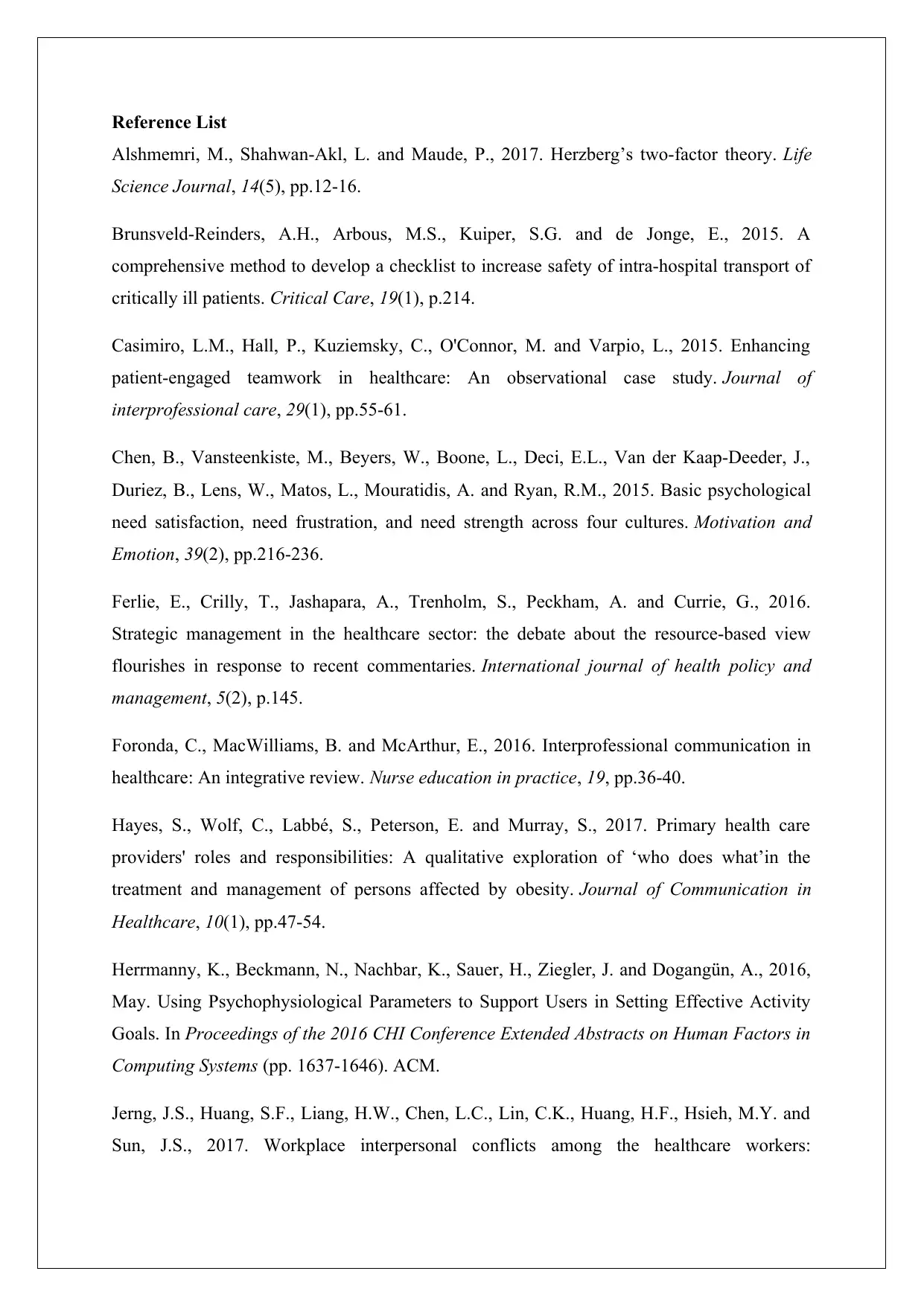
Reference List
Alshmemri, M., Shahwan-Akl, L. and Maude, P., 2017. Herzberg’s two-factor theory. Life
Science Journal, 14(5), pp.12-16.
Brunsveld-Reinders, A.H., Arbous, M.S., Kuiper, S.G. and de Jonge, E., 2015. A
comprehensive method to develop a checklist to increase safety of intra-hospital transport of
critically ill patients. Critical Care, 19(1), p.214.
Casimiro, L.M., Hall, P., Kuziemsky, C., O'Connor, M. and Varpio, L., 2015. Enhancing
patient-engaged teamwork in healthcare: An observational case study. Journal of
interprofessional care, 29(1), pp.55-61.
Chen, B., Vansteenkiste, M., Beyers, W., Boone, L., Deci, E.L., Van der Kaap-Deeder, J.,
Duriez, B., Lens, W., Matos, L., Mouratidis, A. and Ryan, R.M., 2015. Basic psychological
need satisfaction, need frustration, and need strength across four cultures. Motivation and
Emotion, 39(2), pp.216-236.
Ferlie, E., Crilly, T., Jashapara, A., Trenholm, S., Peckham, A. and Currie, G., 2016.
Strategic management in the healthcare sector: the debate about the resource-based view
flourishes in response to recent commentaries. International journal of health policy and
management, 5(2), p.145.
Foronda, C., MacWilliams, B. and McArthur, E., 2016. Interprofessional communication in
healthcare: An integrative review. Nurse education in practice, 19, pp.36-40.
Hayes, S., Wolf, C., Labbé, S., Peterson, E. and Murray, S., 2017. Primary health care
providers' roles and responsibilities: A qualitative exploration of ‘who does what’in the
treatment and management of persons affected by obesity. Journal of Communication in
Healthcare, 10(1), pp.47-54.
Herrmanny, K., Beckmann, N., Nachbar, K., Sauer, H., Ziegler, J. and Dogangün, A., 2016,
May. Using Psychophysiological Parameters to Support Users in Setting Effective Activity
Goals. In Proceedings of the 2016 CHI Conference Extended Abstracts on Human Factors in
Computing Systems (pp. 1637-1646). ACM.
Jerng, J.S., Huang, S.F., Liang, H.W., Chen, L.C., Lin, C.K., Huang, H.F., Hsieh, M.Y. and
Sun, J.S., 2017. Workplace interpersonal conflicts among the healthcare workers:
Alshmemri, M., Shahwan-Akl, L. and Maude, P., 2017. Herzberg’s two-factor theory. Life
Science Journal, 14(5), pp.12-16.
Brunsveld-Reinders, A.H., Arbous, M.S., Kuiper, S.G. and de Jonge, E., 2015. A
comprehensive method to develop a checklist to increase safety of intra-hospital transport of
critically ill patients. Critical Care, 19(1), p.214.
Casimiro, L.M., Hall, P., Kuziemsky, C., O'Connor, M. and Varpio, L., 2015. Enhancing
patient-engaged teamwork in healthcare: An observational case study. Journal of
interprofessional care, 29(1), pp.55-61.
Chen, B., Vansteenkiste, M., Beyers, W., Boone, L., Deci, E.L., Van der Kaap-Deeder, J.,
Duriez, B., Lens, W., Matos, L., Mouratidis, A. and Ryan, R.M., 2015. Basic psychological
need satisfaction, need frustration, and need strength across four cultures. Motivation and
Emotion, 39(2), pp.216-236.
Ferlie, E., Crilly, T., Jashapara, A., Trenholm, S., Peckham, A. and Currie, G., 2016.
Strategic management in the healthcare sector: the debate about the resource-based view
flourishes in response to recent commentaries. International journal of health policy and
management, 5(2), p.145.
Foronda, C., MacWilliams, B. and McArthur, E., 2016. Interprofessional communication in
healthcare: An integrative review. Nurse education in practice, 19, pp.36-40.
Hayes, S., Wolf, C., Labbé, S., Peterson, E. and Murray, S., 2017. Primary health care
providers' roles and responsibilities: A qualitative exploration of ‘who does what’in the
treatment and management of persons affected by obesity. Journal of Communication in
Healthcare, 10(1), pp.47-54.
Herrmanny, K., Beckmann, N., Nachbar, K., Sauer, H., Ziegler, J. and Dogangün, A., 2016,
May. Using Psychophysiological Parameters to Support Users in Setting Effective Activity
Goals. In Proceedings of the 2016 CHI Conference Extended Abstracts on Human Factors in
Computing Systems (pp. 1637-1646). ACM.
Jerng, J.S., Huang, S.F., Liang, H.W., Chen, L.C., Lin, C.K., Huang, H.F., Hsieh, M.Y. and
Sun, J.S., 2017. Workplace interpersonal conflicts among the healthcare workers:
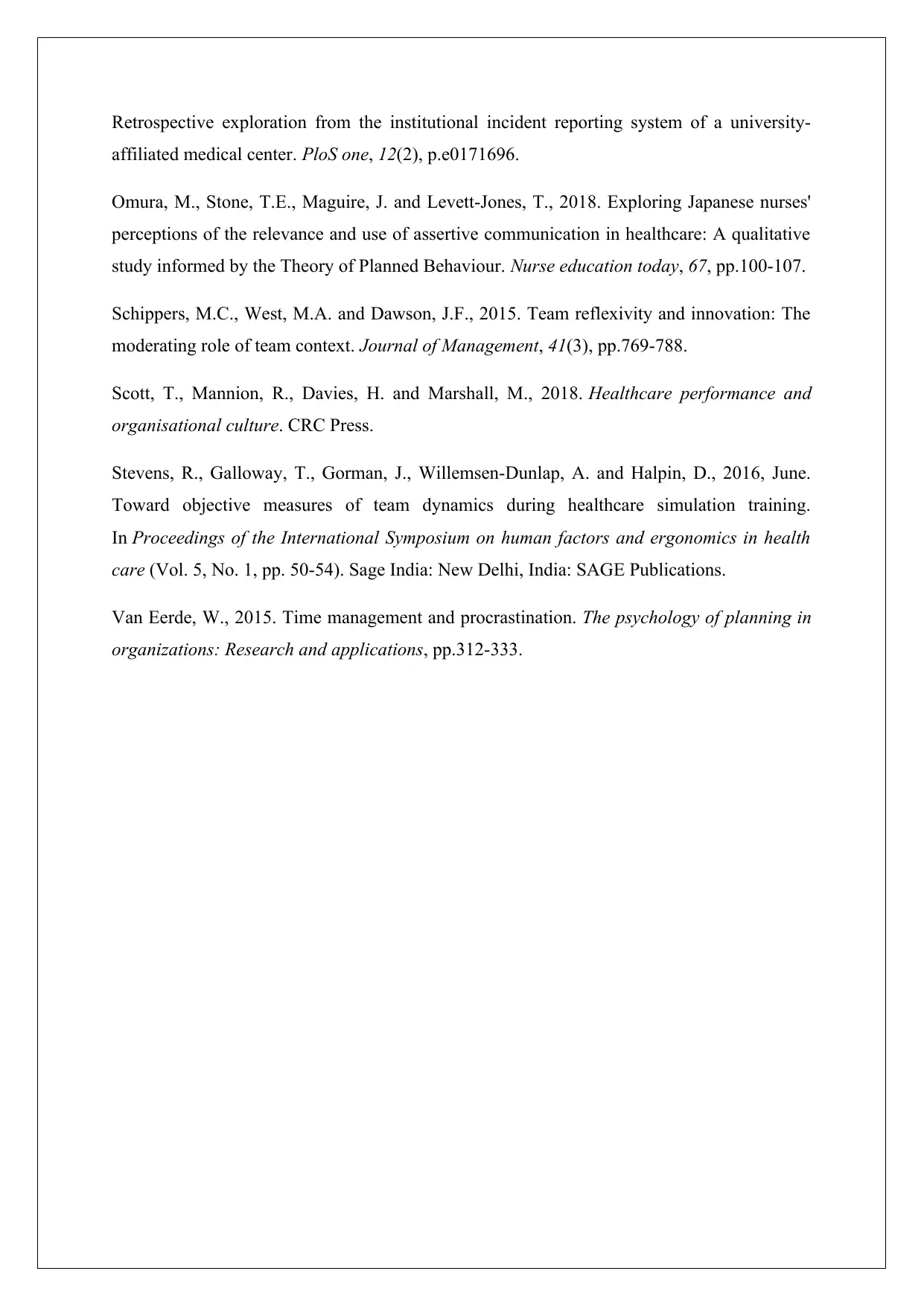
Retrospective exploration from the institutional incident reporting system of a university-
affiliated medical center. PloS one, 12(2), p.e0171696.
Omura, M., Stone, T.E., Maguire, J. and Levett-Jones, T., 2018. Exploring Japanese nurses'
perceptions of the relevance and use of assertive communication in healthcare: A qualitative
study informed by the Theory of Planned Behaviour. Nurse education today, 67, pp.100-107.
Schippers, M.C., West, M.A. and Dawson, J.F., 2015. Team reflexivity and innovation: The
moderating role of team context. Journal of Management, 41(3), pp.769-788.
Scott, T., Mannion, R., Davies, H. and Marshall, M., 2018. Healthcare performance and
organisational culture. CRC Press.
Stevens, R., Galloway, T., Gorman, J., Willemsen-Dunlap, A. and Halpin, D., 2016, June.
Toward objective measures of team dynamics during healthcare simulation training.
In Proceedings of the International Symposium on human factors and ergonomics in health
care (Vol. 5, No. 1, pp. 50-54). Sage India: New Delhi, India: SAGE Publications.
Van Eerde, W., 2015. Time management and procrastination. The psychology of planning in
organizations: Research and applications, pp.312-333.
affiliated medical center. PloS one, 12(2), p.e0171696.
Omura, M., Stone, T.E., Maguire, J. and Levett-Jones, T., 2018. Exploring Japanese nurses'
perceptions of the relevance and use of assertive communication in healthcare: A qualitative
study informed by the Theory of Planned Behaviour. Nurse education today, 67, pp.100-107.
Schippers, M.C., West, M.A. and Dawson, J.F., 2015. Team reflexivity and innovation: The
moderating role of team context. Journal of Management, 41(3), pp.769-788.
Scott, T., Mannion, R., Davies, H. and Marshall, M., 2018. Healthcare performance and
organisational culture. CRC Press.
Stevens, R., Galloway, T., Gorman, J., Willemsen-Dunlap, A. and Halpin, D., 2016, June.
Toward objective measures of team dynamics during healthcare simulation training.
In Proceedings of the International Symposium on human factors and ergonomics in health
care (Vol. 5, No. 1, pp. 50-54). Sage India: New Delhi, India: SAGE Publications.
Van Eerde, W., 2015. Time management and procrastination. The psychology of planning in
organizations: Research and applications, pp.312-333.
1 out of 16
Related Documents
Your All-in-One AI-Powered Toolkit for Academic Success.
+13062052269
info@desklib.com
Available 24*7 on WhatsApp / Email
![[object Object]](/_next/static/media/star-bottom.7253800d.svg)
Unlock your academic potential
© 2024 | Zucol Services PVT LTD | All rights reserved.





